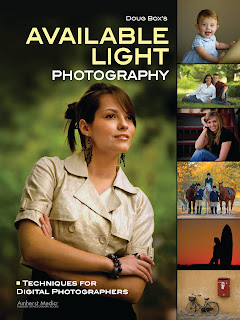
Today's post is an excerpt from the book Doug Box's Available Light Photography: Techniques for Digital Photographers. It is available from Amazon.com and other fine retailers.
REFLECTORS
Photographers use reflectors to bounce light onto the subject or scene. They are available in different sizes and with various surfaces that can be used to intentionally affect the color of the light, making it warmer or cooler.
I use reflectors in many ways—to fill in the shadow side of a subject, as a main light, as a kicker light or rim light, set opposite the main light to add roundness or create tonal separation, to illuminate the background, and more.
Typically I use either a 32-inch round pop-up reflector or a 42-inch Scrim Jim with a reflective panel. However, almost any material with a reflective surface can be used as a reflector. A pop-up or folding windshield shade made of silver Mylar is a perfect emergency reflector. Covering a piece of cardboard with aluminum foil will work when you’re in a bind as well. When doing commercial or product photography, I often used small pieces of foil or Plexiglas mirrors to light a small, dark image area. At a wedding, I once used a white tablecloth to reflect light onto the shadow side of a bride’s face.
In many scenarios, a flash in a small softbox would work just as well as the bounced light from a reflector—or better—but we are learning to use the light that is available.


| This image shows how a reflector should be positioned when it is used as the main light for a standard portrait. Many people position the reflector lower, creating an uplighting effect that is not flattering for every subject. The lower position is best used for producing fill light or when you have the open sky or sun as the main light. Note the surface of this reflector. A soft silver tone is easier on the model’s eyes than a very shiny silver modifier. Also, the light that is produced is softer with this type of reflector. |
Top and bottom—If you use a gold reflector to create fill light, the shadow side of the face will take on a warmer hue. This is hard to correct. I usually use a silver or white reflector for fill. A gold reflector can create a warm main light or a kicker or hair light. Here, I used a 12x12-inch gold fold-up reflector about 30 feet from the subject. I had to move that far away to pick up some direct sunlight to illuminate the subject’s hair. Exposure for both images: f/2.8 and 1/250 at ISO 160.





